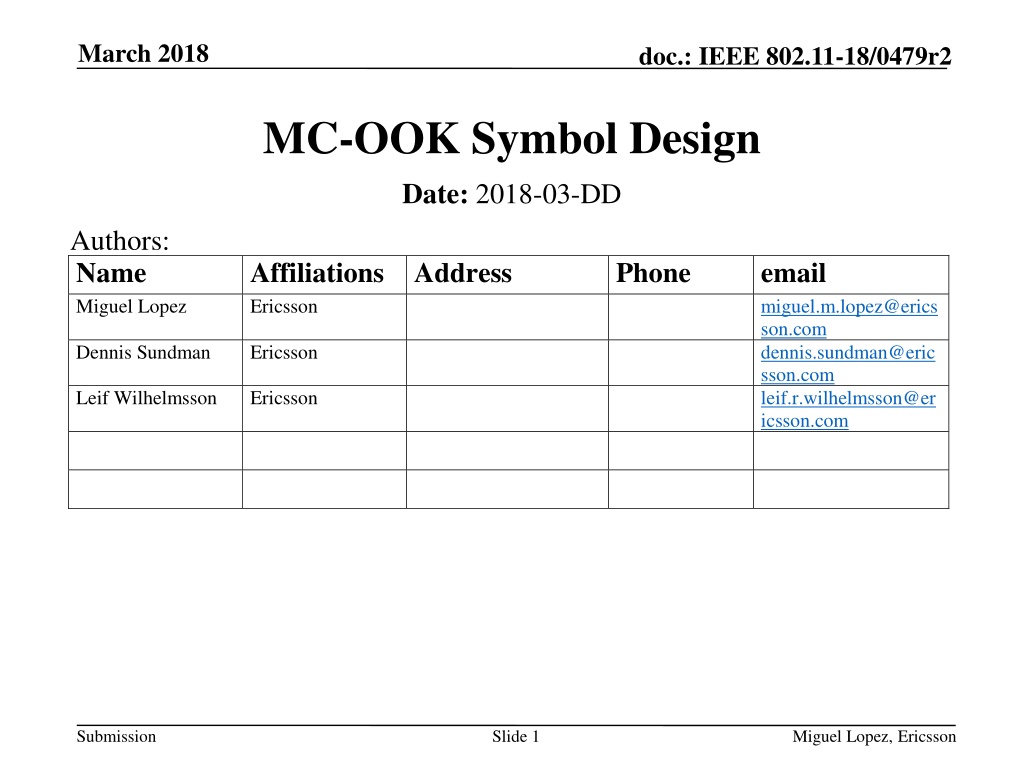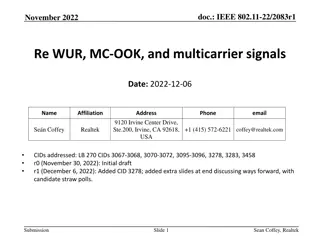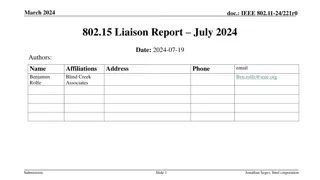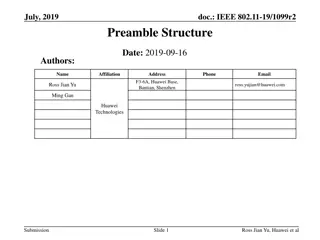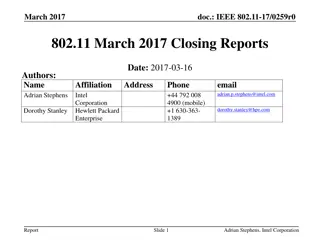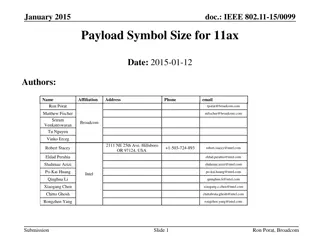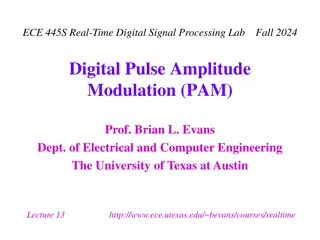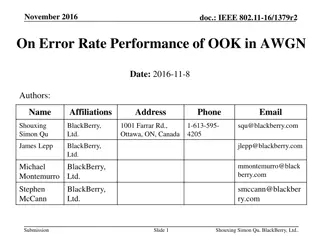MC-OOK Symbol Design for IEEE 802.11 - March 2018
Introducing MC-OOK waveforms with low peak-to-average power ratio for IEEE 802.11, utilizing 256-QAM modulation and 4 MHz bandwidth. The design methodology involves generating time-domain waveforms, transforming to frequency domain, and proposing symbols with and without DC subcarriers. Detailed symbol generation process and instantaneous power analysis are presented.
Download Presentation

Please find below an Image/Link to download the presentation.
The content on the website is provided AS IS for your information and personal use only. It may not be sold, licensed, or shared on other websites without obtaining consent from the author.If you encounter any issues during the download, it is possible that the publisher has removed the file from their server.
You are allowed to download the files provided on this website for personal or commercial use, subject to the condition that they are used lawfully. All files are the property of their respective owners.
The content on the website is provided AS IS for your information and personal use only. It may not be sold, licensed, or shared on other websites without obtaining consent from the author.
E N D
Presentation Transcript
March 2018 doc.: IEEE 802.11-18/0479r2 MC-OOK Symbol Design Date: 2018-03-DD Authors: Name Miguel Lopez Affiliations Address Ericsson Phone email miguel.m.lopez@erics son.com dennis.sundman@eric sson.com leif.r.wilhelmsson@er icsson.com Dennis Sundman Ericsson Leif Wilhelmsson Ericsson Submission Slide 1 Miguel Lopez, Ericsson
March 2018 doc.: IEEE 802.11-18/0479r2 Introduction According to the SFD [1] When a single band is used for transmission of WUR PPDU, the OOK waveform of WUR PPDU is generated by using contiguous 13 subcarriers with the subcarrier spacing of 312.5 kHz: -The center subcarrier is null Low PAPR MC-OOK waveforms have been proposed in [2] and [3] This contribution introduces MC-OOK waveforms that have very low PAPR and good performance The question of the use of the DC subcarrier is revisited Submission Slide 2 Miguel Lopez, Ericsson
March 2018 doc.: IEEE 802.11-18/0479r2 Symbol Generation Methodology Generate a time-domain single carrier waveform (using continuous phase modulation) with constant envelope and 4 MHz bandwidth Transform single carrier waveform to frequency domain Quantize Fourier coefficients to 256-QAM and mute all inactive subcarriers (i.e. null all subcarriers except 13 contiguous subcarriers) multicarrier waveform that resembles constant envelope waveform is generated. Submission Slide 3 Miguel Lopez, Ericsson
March 2018 doc.: IEEE 802.11-18/0479r2 Design for 4 us symbols 64 point IFFT 0.8 us CP Submission Slide 4 Miguel Lopez, Ericsson
March 2018 doc.: IEEE 802.11-18/0479r2 Proposed frequency domain symbols (256-QAM), 4 us symbol Subcarrier Proposed, with DC Proposed, no DC -0.5369 - 0.2301i -0.5369 - 0.8437i -0.0767 - 0.9971i 0.6903 - 1.1504i 0.9971 - 0.3835i -0.6903 - 0.0767i -0.9971 - 0.9971i 0.0767 + 0.6903i -0.3835 + 0.9971i 1.1504 - 0.6903i -0.9971 - 0.0767i 0.8437 + 0.5369i -0.2301 - 0.5369i -6 -0.6903 - 0.3835i -0.5369 + 0.6903i -0.0767 + 0.0767i 0.6903 + 1.1504i 1.1504 - 0.6903i -0.6903 + 0.0767i 0.0000 + 0.0000i 0.0767 - 0.6903i 0.6903 - 1.1504i 1.1504 + 0.6903i -0.0767 + 0.0767i 0.6903 - 0.5369i 0.3835 + 0.6903i -5 -4 -3 -2 -1 DC 1 2 3 4 5 6 Submission Slide 5 Miguel Lopez, Ericsson
March 2018 doc.: IEEE 802.11-18/0479r2 I/Q diagrams of proposed symbols, 4 us symbol Benchmark: opt1 [2] Proposed Submission Slide 6 Miguel Lopez, Ericsson
March 2018 Instantaneous power of proposed MCS- OOK waveforms, 4 us symbol doc.: IEEE 802.11-18/0479r2 Submission Slide 7 Miguel Lopez, Ericsson
March 2018 doc.: IEEE 802.11-18/0479r2 MC-OOK waveform performance Data rate: 62.5 kbps, 4 us symbols Waveform PAPR (dB) SNR (dB) @10% PER AWGN -9.1 -8.5 SNR (dB) @10% PER TGnB 0.1 0.1 SNR (dB) @10% PER TGnD -0.9 -2.2 DC only Random QPSK Opt 1 [1] Proposed with DC Proposed no DC 0 > 5 0.0 0.0 -2.3 -2.3 2.1 0.6 -8.8 -8.7 0.0 -2.3 1 -8.9 Submission Slide 8 Miguel Lopez, Ericsson
March 2018 doc.: IEEE 802.11-18/0479r2 Performance 62.5 kbps Submission Slide 9 Miguel Lopez, Ericsson
March 2018 doc.: IEEE 802.11-18/0479r2 Design for 2 us symbols 32 point IFFT 0.4 us CP Submission Slide 10 Miguel Lopez, Ericsson
March 2018 Proposed frequency domain 2us symbols (256-QAM) doc.: IEEE 802.11-18/0479r2 Subcarrier Proposed, no DC 0.2301 + 0.5369i 0.0767 + 1.1504i -0.3835 + 0.9971i 0 0.9971 - 0.3835i -1.1504 - 0.0767i 0.5369 + 0.2301i -3 -2 -1 DC 1 2 3 Submission Slide 11 Miguel Lopez, Ericsson
March 2018 doc.: IEEE 802.11-18/0479r2 I/Q diagrams of proposed 2 us symbols Benchmark: trade-off [3] Proposed Submission Slide 12 Miguel Lopez, Ericsson
March 2018 doc.: IEEE 802.11-18/0479r2 MC-OOK waveform performance Data rate: 250 kbps, 2us symbols Waveform PAPR (dB) SNR (dB) @10% PER AWGN -4.1 SNR (dB) @10% PER TGnB 4.8 SNR (dB) @10% PER TGnD 1.7 Random QPSK Best tradeoff [3] Proposed no DC > 5 1.0 3.5 -4.1 4.7 0.6 -4.7 4.6 1.3 Submission Slide 13 Miguel Lopez, Ericsson
March 2018 doc.: IEEE 802.11-18/0479r2 Performance 250 kbps using 2 us symbols Submission Slide 14 Miguel Lopez, Ericsson
March 2018 doc.: IEEE 802.11-18/0479r2 Observations 1 Low PAPR waveforms are advantageous. May help the transmitter to boost the power of the OOK signal without exceeding the limits on out of band emissions. There are many waveforms that yield relatively poor link performance. E.g., the simulations in [3] show large performance spread among various sequences Constant envelope waveforms exhibit the best performance in AWGN Waveforms with equal power in all active subcarriers exhibit the best performance in fading channels, due to harvesting of frequency diversity Proposed waveforms have nearly constant envelope Proposed waveforms don t have zero crossings Submission Slide 15 Miguel Lopez, Ericsson
March 2018 doc.: IEEE 802.11-18/0479r2 Observations 2 Proposed waveforms show gains in AWGN channel, with respect to waveforms with equal power in all active subcarriers 62.5 kbps 0.2 dB gain 250 kbps 0.6 dB gain Proposed waveforms may suffer small losses at high SNR in fading channels, with respect to waveforms with equal power in all active subcarriers 62.5 kbps 250 kbps No losses for TGnB No losses for TGnB 0.3 dB loss for TGnD @ 10% PER No losses for TGnD @ 10% PER Submission Slide 16 Miguel Lopez, Ericsson
March 2018 doc.: IEEE 802.11-18/0479r2 Observations 3 The proposed waveforms have a substantially lower PAPR than other MC-OOK waveforms presented in [2], [3] 62.5 kbps 250 kbps PAPR reduction 1.1dB -1.6dB PAPR reduction 2.9dB Proposed waveforms are advantageous when the TX is PA limited Use of the DC subcarrier allows a PAPR reduction of 0.5 dB compared to waveform with null DC (62.5 kbps only) Submission Slide 17 Miguel Lopez, Ericsson
March 2018 doc.: IEEE 802.11-18/0479r2 Straw poll Do you support the specification of the frequency domain symbols corresponding to the MC-OOK waveforms? Y N A Submission Slide 18 Miguel Lopez, Ericsson
March 2018 doc.: IEEE 802.11-18/0479r2 References [1] IEEE 802.11-17/0575r9 Specification Framework for TGba [2] IEEE 802.11-17/0964r4 Signal Bandwidth and Sequence for OOK Signal Generation [3] IEEE 802.11-18/0097r0 2 us OOK pulse for high rate Submission Slide 19 Miguel Lopez, Ericsson
March 2018 doc.: IEEE 802.11-18/0479r2 Appendix PSD of OOK signals using proposed waveforms, with windowing according to equation (17-5) IEEE 802.11- 2016 Submission Slide 20 Miguel Lopez, Ericsson
